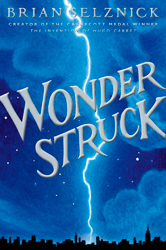Illustrated middle-grade fiction
The continuation of a popular comic novel series, new work from a Caldecott Medal winner, and a novel about the 1950s Soviet Union — three new illustrated novels feature compelling stories not only for proficient middle-grade readers but for reluctant ones, as well.
 Big Nate on a Roll by Lincoln Peirce is the third (mis)adventure of hapless Nate Wright. Here the sixth grader finds himself in fierce, albeit one-sided, competition with Artur, the all-around good guy who always wins everything. Nate is not about to let Artur win a new skateboard (the prize for a scouts fundraising drive), so he cooks up some inventive, mostly self-defeating, schemes to beat him. The interplay between text and drawings remains fresh, and Nate’s own cartoons are almost as funny as Peirce’s. (8–12 years)
Big Nate on a Roll by Lincoln Peirce is the third (mis)adventure of hapless Nate Wright. Here the sixth grader finds himself in fierce, albeit one-sided, competition with Artur, the all-around good guy who always wins everything. Nate is not about to let Artur win a new skateboard (the prize for a scouts fundraising drive), so he cooks up some inventive, mostly self-defeating, schemes to beat him. The interplay between text and drawings remains fresh, and Nate’s own cartoons are almost as funny as Peirce’s. (8–12 years) Caldecott-winner Brian Selznick (The Invention of Hugo Cabret) again plays with form in his latest book, Wonderstruck. Text and art tell two separate stories that eventually meet: the wordless pictures (pencil, double-page spread) follow a young deaf girl, Rose, living in 1927 Hoboken; the text is set in 1977 Minnesota where Ben struggles with the death of his mother and the loss of his hearing. For different reasons, both children strike out on adventures to New York City and end up at the Museum of Natural History. Ben and Rose are openhearted and easy to love, providing this intricate puzzle of a plot with a generous and welcome shot of emotion. (9–12 years)
Caldecott-winner Brian Selznick (The Invention of Hugo Cabret) again plays with form in his latest book, Wonderstruck. Text and art tell two separate stories that eventually meet: the wordless pictures (pencil, double-page spread) follow a young deaf girl, Rose, living in 1927 Hoboken; the text is set in 1977 Minnesota where Ben struggles with the death of his mother and the loss of his hearing. For different reasons, both children strike out on adventures to New York City and end up at the Museum of Natural History. Ben and Rose are openhearted and easy to love, providing this intricate puzzle of a plot with a generous and welcome shot of emotion. (9–12 years) In Eugene Yelchin’s Breaking Stalin’s Nose, ten-year-old Sasha Zaichik wants to become a Young Pioneer and show his devotion to Stalin and the Communist party. But when his father, a member of the secret police, is arrested in the middle of the night leaving Sasha all alone, and things go from bad to worse for him the next day at school, Sasha’s illusions about his life begin to unravel. Yelchin’s menacing illustrations add an ominous tone to the briskly paced story that slowly peels off the layers of Sasha’s naiveté to expose the brutality of the system he blindly followed. (9–12 years)
In Eugene Yelchin’s Breaking Stalin’s Nose, ten-year-old Sasha Zaichik wants to become a Young Pioneer and show his devotion to Stalin and the Communist party. But when his father, a member of the secret police, is arrested in the middle of the night leaving Sasha all alone, and things go from bad to worse for him the next day at school, Sasha’s illusions about his life begin to unravel. Yelchin’s menacing illustrations add an ominous tone to the briskly paced story that slowly peels off the layers of Sasha’s naiveté to expose the brutality of the system he blindly followed. (9–12 years)—Cynthia K. Ritter
From Notes from the Horn Book, September 2011
says
Add Comment :-
RELATED
RECOMMENDED
ALREADY A SUBSCRIBER? LOG IN
We are currently offering this content for free. Sign up now to activate your personal profile, where you can save articles for future viewing.







